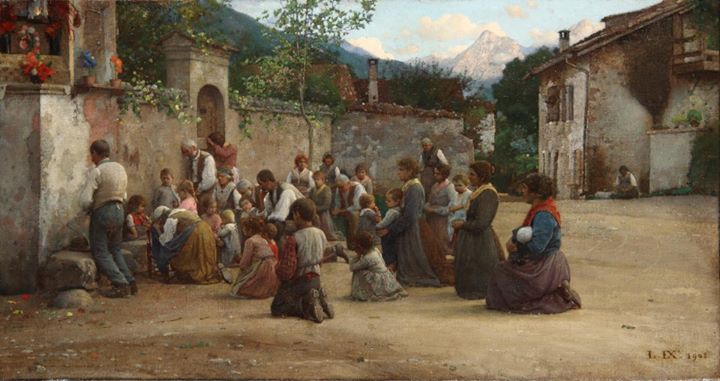
The Spiritual Works of Mercy – Praying to God for the Living and the Dead
The Works of Mercy recommended by the Church do not have priority over one another, but all are of equal importance

Considering that Jesus, in his great Mercy, has always prayed for all of us and still prays, in his eternal time, praying for others is a charity of irreplaceable intercession for the living and the dead. Jean Francois Millet (1814/1875), one of the greatest exponents of realism, recounts, “This is a picture I painted remembering the days when we worked in the fields and my grandmother, whenever she heard the bell tolling, made us stop to recite the angelus in memory of the poor departed.” The painting, now in the Musée d’Orsay in Paris, commissioned in 1858/59 and admired by the great Dali, has the very title “Angelus.” Millet, who came from a family of farmers, was always attracted to the life of the fields and peasants because of that sincere humility that comes from a conscious acceptance of their task that comes from God. In this painting, the two peasants pause at the sound of the bells of Chailly-En-Biere, which seem to mark the stages and flow of rural life. Leaving the wheelbarrow and trident behind, the man removes his hat as if he were in church, while the woman bends more to recite her prayer. The magic of the recollection is rendered with rare intensity; everything is underscored by a twilight light coming from the horizon, which sets the characters and the vast field against the light, where the outline of a church is barely visible, making the scene suffused with an atmosphere of high morality and religious mercy toward others.

The mystery of memories mixed with grief strongly recall the idea of the cemetery as a place of silence and recollection, where one tries to accept everything only through prayer and Christian hope. Bocklin’s Island of the Dead, painted in several versions, the first version in 1880 at the Basel Museum of Art, initially related to the death of his daughter during his stay in Florence from 1874 to 1885, condenses the two opposing conceptions related to the idea of the passage from death to eternity. Arnold Bocklin (1827/1901), who was born in Basel and died in Fiesole, was one of the authors who illustrated his conception between life and death in a very special way. In this painting he places at the center a small but majestic island rising out of the dark water in front of a sky traversed by gray clouds. A boat sails toward the island with a mysterious figure cloaked in white, like a statue adorning the tombs, who seems to be guarding a small coffin placed at the bow, while the boatman dives his oars into the water without making a sound. The rocks that, steep and imposing greet the dense group of tall cypress trees that hide the entrance, also seem to invite recollection and prayer through a special light that brings nature’s colors alive and softens the sense of grief and death.

A breath of humble hope that leads to the beauty of prayer can be found in some paintings by Vincenzo Cabianca, who was born in Verona in 1827 and died in Rome in 1902. In close contact with the Tuscan Macchiaioli, he became a significant exponent of their daily life, deepening the rendering of light and shadow through the skillful juxtaposition of patches of color. In the two paintings entitled “Matins” and “Le Monachelle,” we seem to savor the time devoted to prayer. From the solitary prayer of a priest, to the small community of nuns who, from the height of a convent or an isolated little church, look out from a parapet that allows a view of the sea, the mind goes to the infinite creation of God. It is the prayer of the living and the dead, to which certainly the protagonists, far from any din, devote themselves with serene attention, that engages us in appreciating this important work of mercy.

Another great observer of the reality close to his time was Luigi Nono (1850//1918) a leading exponent of the Venetian school and teacher of painting at the Academy of Venice and Bologna. To him we owe a work that takes us back to the bygone days when people gathered to pray in the small courtyards or courtyards of humble houses outside the city: “Evening Prayer.” The scene is set in the small square of Tortesen (Feltre), where a community, mostly peasants, gathers to pray together by a small wall supporting a shrine. Men and women, old people and children, almost all kneeling, with great dignity and recollection, are facing the wayside shrine where the author does not show to whom it is dedicated, to give more importance to the praying group. The warm colors of the robes, the uneven pavement and the houses, in harmony with the green of the trees from which a large white mountain emerges in the distance, almost make the observer a participant in this intimate prayer that goes out to the living and the dearly departed. Certainly our prayer cannot be matched by that of Jesus, so suffered in the Garden of Olives and so constantly merciful to those who suffer, but it will always be a priority not to be overlooked in our sleepless days and nights.

